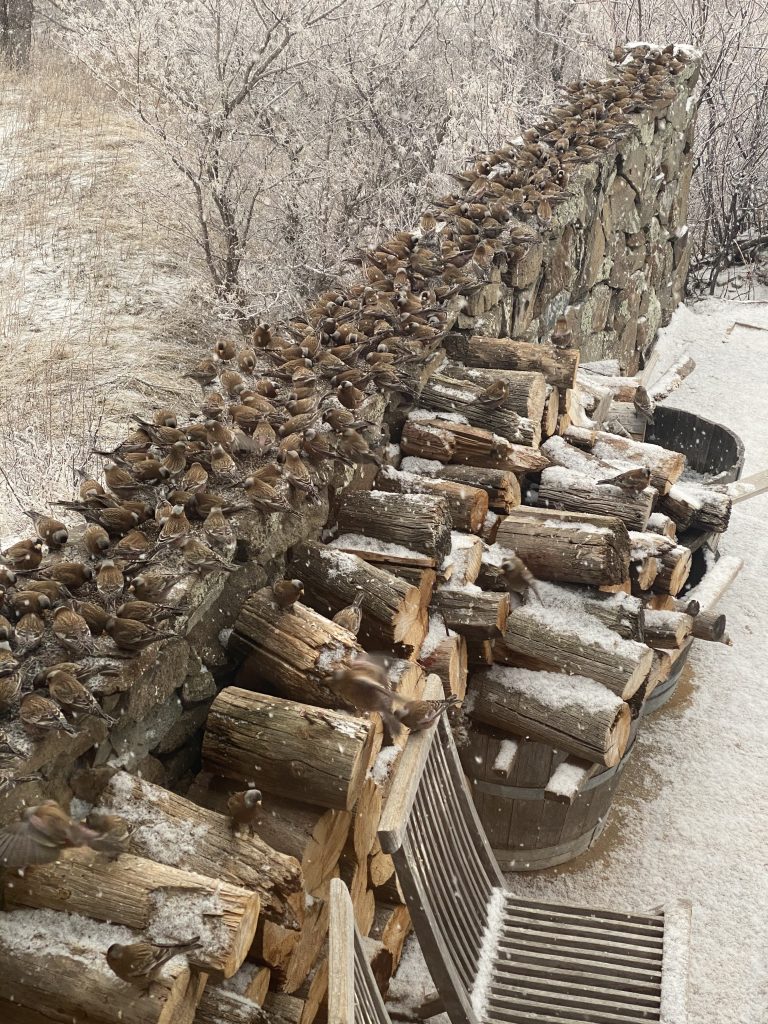By Dr. Lynne Spriggs O’Connor:
On October 23rd, I received an exciting message from a friend who lives in Glacier National Park. Kelly is a birder and leads nature hikes through Glacier.
“Saw lots of your gray-crowned rosy finches yesterday eating grass seed, they left their tracks and wing marks all over the snow. Around 9:30 this morning I saw them at 5,400 ft, and more signs all along where we skied up to 6,000 ft.. Get ready, I’m sure they’re on their way to you!”
Eight days later, on this year’s Blue Moon Halloween, I rise to find our first three Gray-crowned Rosies outside kitchen windows. What joy! They perch along one rock wall as I pour thistle seed along the other. These finches are fearless, highly sociable, remarkably friendly. They rise to perch nearby on their favorite leeside east-facing stone chimney. This spot, where hundreds gather multiple times each day, resembles their natural habitat of high rocky cliffs. Located only fifty feet from our kitchen porch feeding area, they are perfectly camouflaged, warmed by the sun’s first light each morning, and protected from prevailing winds.
My husband and I live in an isolated mountain valley in central Montana, less than two hundred miles southeast of Glacier Park. Bordered on three sides by National forest, our valley in the Highwoods extends from 4,500 to 7,000 feet in altitude. The Highwood Mountains are one of several “island ranges” that jut up from Montana’s prairie lands, east of the Rockies. Our only human encounters are with the family who helps us run our cattle ranch. Daily relationships center around a variety of animals, both domestic and wild, who share this diverse mountain habitat. We first took notice of these unusual winter finches back in 2007, when we counted about sixty. Now, a flock of some four hundred and fifty Gray-crowned Rosy Finches stay with us each winter for five months.
These beloved winter acquaintances come to us from a dramatic world high in the clouds.
Northern summer nesting grounds are in remote landscapes. Gray-crowned Rosy Finches are quite possibly the highest altitude breeding birds on the North American continent. For this reason, they remain largely hidden to most people. Even in colder months, they prefer extreme environments for their wintering grounds. We feel lucky to know them.
When they first arrive outside our kitchen windows each October or November, our hearts jump. We take great pleasure in caring for them, as one does with any welcome guests. No other birds at the feeder give us a stronger sense of their energy. We respond to their calls, and they to ours.
For nearly half of each year, we eat meals at our kitchen table while just beyond glass doors and windows, only a few feet away, a growing number of Gray-crowns eat meals of seed. When they rise, their shadows flicker across the kitchen’s walls and ceiling. We often pause to admire their cinnamon brown plumage, rosy pink on their shoulders, flanks, and bellies, foreheads dark with gray-colored patches on backs of heads and bellies. At least once a day, we stop speaking mid-sentence, in awe. Their beauty in flight is enthralling. Their movements stirring and rousing, their spirits intrepid. They face gale force winds, frigid temperatures, and driving snow with aplomb. These stout birds seem to know everything about how easily to survive what is harsh and difficult for most.
In the wonder of these hardy and affable companions, we don’t feel alone over the dark months of Montana’s winters. Each April we grow wistful in anticipation of their departure. In their absence, we dream of their migration back to rocky clifftops on the highest of mountains. We wonder where they go. Will their nests be built in the clouds? Will they raise their young in these high peaks, and return to us again next November?
Dr. Lynne Spriggs O’Connor is a writer and rancher. She has written several blogs here for FiRN named Finches of Cloudland, and her upcoming memoir is titled Elk Love: A Montana Memoir, where she writes about her special relationship with the Rosy-Finches that have visited her and her husband over the years.
FiRN is a nonprofit, and has been granted 501c3 status. FiRN is committed to researching and protecting these birds and other threatened finch species like the Evening Grosbeak and Rosy-finches, and if you have been enjoying all the blogs and identifying of Red Crossbill call types, redpoll subspecies and green morph Pine Siskins FiRN has helped with, please think about supporting our efforts and making a small donation at the donate link below.

Fore more about Finches of Cloudland and the Rosy-Finch Project, read below:

